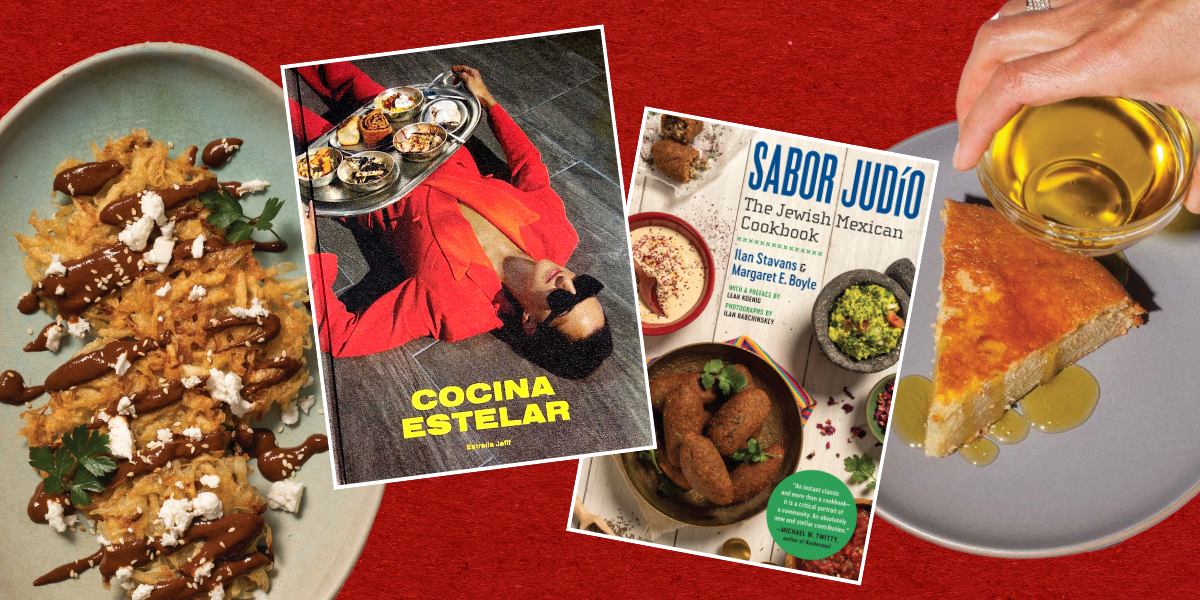Food
Inside the Mexican Jewish ‘Cocina’

When Margaret E. Boyle invited Ilan Stavans to an academic conference in Maine in 2016, neither had an inkling that it would be the beginning of a delicious—and prolific—friendship.
Boyle and Stavans, both scholars and professors of Latin culture—Boyle at Bowdoin College in Maine and Stavans at Amherst College in Massachusetts—quickly connected over their shared Mexican Jewish heritage. Mexican-born Stavans moved to the United States in his 20s, while Boyle was born in California to a large Mexican Jewish family.
Lightning truly struck when they discovered they both had women in their families who had compiled Mexican Jewish cookbooks that, through recipes and stories, lent insight into the storied history of Jews in Mexico as well as the aromas and flavors of their cocinas, or kitchens. Stavans’ mother, Ofelia Slomianski, had created a handwritten notebook filled with the recipes of her mother, known as Bobe Miriam, forming a time capsule of Mexican Jewish life since her emigration from Eastern Europe in the 1920s.
Boyle’s great-grandmother, Baba Malka Poplawski, had begun a similar notebook that her progeny annotated while she was still alive and cooking in Mexico City.

“We realized we were both sitting on goldmines,” Boyle said by phone from Maine. The two decided to expand on their legacies. They placed an advertisement in 2020 in Diario Judeo, Mexico’s largest Jewish newspaper, asking for additional recipes and stories from the contemporary Jewish communities all over Mexico. The result is Sabor Judio: The Jewish Mexican Cookbook, which was published in October.
“The response was overwhelming in a good way,” Boyle said. “People really just wanted to share their stories.”
The respondents came from a cross-section of Mexico’s more than 40,000 Jews, the majority of whom live in Mexico City and whose history is remarkable for its diversity. There are the ancestors of Sephardi crypto-Jews, who went underground with their Jewish practice to survive the Spanish Inquisition. In the 1800s, a wave of Ashkenazi Jews came seeking refuge from persecution in Eastern Europe. Also represented are a dwindling number of Holocaust survivors and Jews who fled from countries like Syria, Turkey, Iran and Lebanon as the Ottoman Empire crumbled.
Some of those Sephardi and Mizrahi Jews were the parents and grandparents of Estrella Jafif, a celebrity chef who spent most of her career trying to sidestep her heritage, focusing instead on non-kosher recipes that she served at high-end catering events and the restaurants owned by her family. But during the Covid-19 pandemic, Jafif began spending significant time in the kitchen with her relatives. She took copious notes on her family’s recipes and fused them with her own more modern dishes to create the Spanish-language cookbook, Cocina Estelar (stellar cooking), which was released earlier this year.

“My mother was born in Cuba, my maternal grandmother in Turkey, my mother-in-law in Lebanon and my paternal grandmother in Mexico, but she had a very marked Arab and Syrian influence,” Jafif said by phone from her home in Mexico City. “For them, practicing their cooking is preserving their traditions and their essence. What I like most is the unique mix that arises when you serve a Syrian kibbeh (fried stuffed bulgur) and Cuban chicken and rice at the same table. That’s how we ate in my house.”
Pati Jinich, perhaps the best-known Mexican Jewish food maven for her string of best-selling cookbooks and public television series, Pati’s Mexican Table, describes a similar amalgamation of Jewish heritage and native cooking techniques. “As Jews grew roots in Mexico they integrated local flavors, helping form a unique ‘regional’ Jewish cuisine,” Jinich said. “The cuisine continues to evolve as Mexico evolves. My hope is that more and more people get to know how unique Mexican Jewish food is, which helps give a face to the community.”
Jafif’s Tamarind Chicken is the perfect fusion of an ingredient used in both Mexican and Mizrahi kitchens and would make a delicious centerpiece for a Hanukkah dinner. For a dairy holiday meal, try Latkes con Mole, a recipe that Stavans’ wife, Alison Sparks, adapted from her mother-in-law and that pairs a traditional savory, chocolate-based sauce with crisp-fried potato pancakes. And feel good about eschewing sufganiyot this year in favor of Jafif’s more healthful and sophisticated Olive Oil Cake.

Latkes con Mole — Serves 8
INGREDIENTS
For the latkes:
- 4 pounds russet potatoes, scrubbed and peeled
- 1 medium yellow onion, peeled
- 1/2 cup potato starch
- 1 tablespoon kosher salt
- 4 large eggs, lightly beaten
- Vegetable oil, for frying
For the mole:
- 2 tablespoons vegetable oil
- 1 small white onion, finely chopped
- 1 (8-ounce) jar prepared mole
- 3 cups chicken or vegetable broth
- 2 ounces bittersweet chocolate, roughly chopped
For serving:
- Crumbled queso fresco
INSTRUCTIONS
- Make the latkes: Line 2 large baking sheets with several layers of paper towels and set aside.
- Grate the potatoes and onion on the large holes of a box grater. (Or cut them into quarters and shred using the shredding disc of a food processor.) Working in batches, wrap the shredded potatoes and onion in a clean tea towel and squeeze out as much water as possible.
- Add the shredded potatoes and onion to a large bowl along with the potato starch, salt and eggs. Mix until fully incorporated
- In a large frying pan, heat 1/4 inch of oil over medium-high heat until shimmering but not smoking.
Working in batches of 4-5, drop 1/4 cup of batter into the pan and press gently with a spatula to flatten slightly. Cook, flipping once, until browned on both sides and cooked through, 6-8 minute per batch, then transfer to the prepared baking sheets to drain. - Continue with the remaining latke mixture, adding more oil as necessary and adjusting the heat up or down if the latkes are browning too quickly or not quickly enough. The latkes can be kept warm in the oven while preparing the mole.
- Make the mole: Heat the oil in a large saucepan set over medium heat. Add the onion and cook, stirring often, until softened, 6-8 minutes.
- Add a heaping tablespoon of the prepared mole, stirring to combine it with the onion, then add 1 cup of the broth. Bring to a boil, then lower the heat to medium low and cook, stirring often, until the mixture reaches the consistency of thick soup.
- Continue adding the prepared mole and the remaining broth, a little at a time, until both are completely used up. Continue cooking the mixture, stirring often, until it turns into a thick, rich sauce. Add the chocolate, stirring to melt, then remove from the heat.
- Serve latkes hot, topped with mole and crumbled queso fresco.

Olive Oil Cake — Serves 10-12
INGREDIENTS
- 2 cups flour
- 1 1/4 cups sugar
- 1 1/2 tablespoons salt
- 1/2 tablespoon baking soda
- 1/2 tablespoon baking powder
- 1/2 cup extra virgin olive oil
- 1 1/4 cup whole milk
- 3 eggs
- 1 orange, zested
- 1/4 cup orange juice
- 1/4 cup Grand Marnier (optional)
For the whipped cream:
- 1/2 cup whipping cream
- 1/2 cup sugar
For the decoration:
- Orange marmalade
- 6 tablespoons olive oil
- 1/4 cup pistachios, shelled, toasted and roughly chopped
- Orange zest
INSTRUCTIONS
- Preheat the oven to 350°. Grease a round cake pan with butter and flour.
- In a bowl, combine flour, sugar, salt, baking soda and baking powder and mix well.
- In a separate bowl, combine olive oil, milk, eggs, orange zest and juice and Grand Marnier. Beat well.
- Add the wet ingredients to the dry ingredients and mix until you have a smooth and uniform batter.
- Pour the batter into the greased mold and bake for 45 minutes, until golden.
- Make the whipped cream: Add cream and sugar to a mixer and whip until you have a thick and spreadable whipped cream. Fold in the pistachios with a spatula.
- Slice the cake after it has cooled, place a dollop of whipped cream on top, then some marmalade and orange zest. Finish with a drizzle of olive oil and toasted pistachios.

Tamarind Chicken — Serves 6
INGREDIENTS
- 1 whole chicken, separated into parts
- Salt
- Pepper
- 1 cup tomato puree
- 1/2 cup tamarind concentrate or pomegranate molasses
- 2 limes, juiced
- 2 cups water
- 2 cups dried fruit (apricot, fig, plum)
- 3 tablespoons brown sugar
- 1/2 teaspoon cumin
INSTRUCTIONS
- Season the chicken with salt and pepper.
- Sear the chicken on all sides in a hot pan.
- To a bowl, add the tomato puree, tamarind concentrate, lime juice, salt, pepper and 2 cups of water.
- Add the tomato puree mixture to a deep pot, along with the chicken and the dried fruits.
- Boil for 40 minutes on low heat, until the sauce reduces and the chicken is fully cooked.
- Serve the chicken with rice, couscous or quinoa.
Adeena Sussman lives in Tel Aviv. She is the author of Shabbat: Recipes and Rituals from My Kitchen to Yours and Sababa: Fresh, Sunny Flavors from My Israeli Kitchen. Sign up for her newsletter at adeenasussman.substack.com.










 Facebook
Facebook Instagram
Instagram Twitter
Twitter
Paulette Fraenkel says
Are your recipes for Kosher Kitchens?